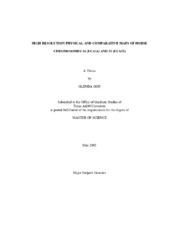| dc.description.abstract | In order to identify genes or markers responsible for economically important traits in the
horse, the development of high resolution gene maps of individual equine chromosomes
is essential. We herein report the construction of high resolution physically ordered
radiation hybrid (RH) and comparative maps for horse chromosomes 14 and 21 (ECA14
and ECA21). These chromosomes predominantly share correspondence with human
chromosome 5 (HSA5), though a small region on the proximal part of ECA21
corresponds to a ~5Mb region from the short arm of HSA19. The map for ECA14
consists of 128 markers (83 Type I and 45 Type II) and spans a total of
1828cR.Compared to this, the map of ECA21 is made up of 90 markers (64 Type I and
26 Type II), that segregate into two linkage groups spanning 278 and 760cR each. A
total of 218 markers provide on average one marker every 0.9Mb along the length of the
two equine chromosomes. This represents a 5-fold improvement over the previous maps.
Of greater significance is the ~8-fold increase in the density of Type I loci that provide a
comprehensive and finely aligned map for the two chromosomes in relation to
homologues in a range of evolutionarily distantly related species, viz., human,
chimpanzee, mouse, rat, dog, cattle, pig, cat and chicken. The orientation and alignment of the linkage groups was strengthened by 28 new FISH localizations, of which 27 are
gene-specific (22 from HSA5 and 5 from HSA19). Comparative analysis between the
horse and human reveals that the order of genes on HSA5 is remarkably well conserved
in the horse, with an evolutionary break/fusion point that could be correlated to a ~2Mb
region between 68.5 – 70.9Mb positions on HSA5. Among the species analyzed to date,
the HSA5 and 19p neighboring segment combination is unique to Perissodactyls and
Cetartiodactyls, but, in the Perissodactyls, the portion of HSA5 that corresponds to this
combination is HSA5p – q13, while in the Cetartiodactyls, it is HSA5q13 – qter. This
leads us to postulate that this neighboring segment combination arose as separate events
during the divergence of Perissodactyls and Cetartiodactyls from a common ancestor. | en |


